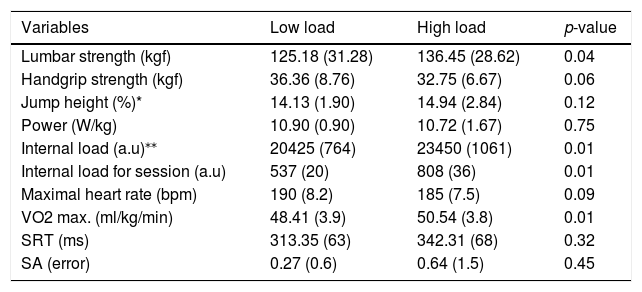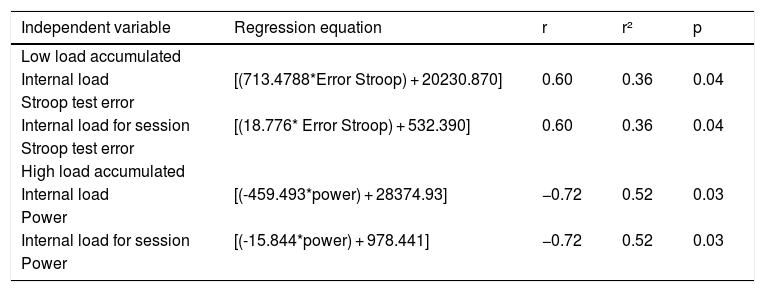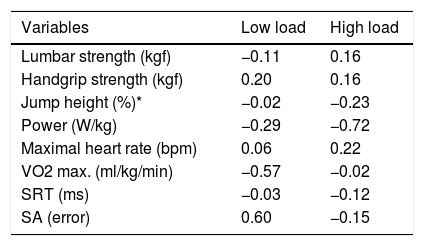Understanding how external and internal loads relate during a competitive season in high performance athletes, and identifying which capacities have more influence on the perception of effort, can help to better plan training and monitor competitive performance.
Material and MethodsIn this study we followed a professional male futsal team (n = 11) over a 37-week competitive season to determine variables that influence the perceived effort in periods of low and high training loads. External load indicators (strength, power, cognitive performance, sleep quality, and cardiorespiratory fitness) and the perception of effort were monitored regularly. The significance level adopted for this study was p <0.05.
ResultsIn the period of low accumulated load, poor cognitive performance was directly related to the perception of effort at a greater extent (rho = 0.60; p = 0.048), while in the period of high load the power production capacity was inversely related with perceived effort (r = - 0.72; p = 0.02).
ConclusionsBoth cognitive performance and explosive force production should be monitored throughout the regular season, but planning should seek to enhance these specific factors at different times of the season.
Futsal is an acyclic sport with high neuromuscular demands involving accelerations, decelerations, changes of direction, jumps, and kicks. At competitive level, players average more than 3000 meters and up to 26 sprints per match mostly at high intensities (15.5–18.3 km/h).1 In addition, futsal involves a variety of rapid decision-making situations, suggesting that in addition to physical ability, sustained attention and decision-making are also critical.1
A balance between external and internal training loads help athletes sustain the high neuromuscular/cognitive demand several times a week for an entire competitive season, which may last 36 to 44 weeks.2 Internal load, as defined by the athlete's responses to an external demand,3 can be estimated by perceived exertion and directly relates to physiological performance markers such as blood lactate concentration and heart rate.4 The perception of effort also depends on emotional reactions being influenced by conditions like mental fatigue.5,6 External load is related to the work imposed and performed by an athlete, often measured by exposure time, speed, distance, volume, or intensity of movement.2 The external load can be manipulated to promote changes in the internal load resulting in training adaptations.2 In this scenario, the monitoring and planning of internal and external loads are important components of futsal physical training, although they are not simple to determine, and there is little information about factors that influence internal loads in high performance athletes, especially during a whole competitive season.7,8
The number and concentration of matches over a period of time influences the perception of internal load,7 but also the different times of the season affect these loads differently between athletes according to their physical characteristics9 and aerobic capacity.8 Cognitive condition, mental fatigue and stress can also have a direct influence on physical capacity and perceived exertion.10 The determination of which neuromuscular and cognitive characteristics influence internal loads in cross-sectional analysis is limited because it might not be sensitive to the evolutions during repeated exercise sessions over a season. Tracking changes during the competitive season becomes more substantial to provide evidence that translates into the optimization of periodization processes and training schedules. After all, different of the observed for an exercise session, the season involves more fluctuations in external and internal loads.11
Whether the perception of internal load relates to physical and/or cognitive ability differently, and whether this relationship changes over a regular season are the questions that motivated our study. Although the literature provides evidence regarding training programs12 and effective methods for improving physical qualities common to futsal and similar sports,13 little is known about how physical and cognitive qualities can influence perception of internal load, especially at different stages of the season. Here we determine which variables can influence the internal load during periods of high and low internal load accumulated in a professional futsal team.
Materials and methodsParticipants and study designThis is an observational study and was conducted at a professional men's futsal club. Participants were those main team athletes who remained active (no injury, time off, or transfer between teams) throughout the entire season. The participants were enrolled in regular futsal training for 6 days a week, including matches that were part of the state level competition calendar. To participate in the study, athletes were required to attend at least 80% of training sessions and all official matches during the season. None of the participants suffered injuries to the lower limbs during the last year. They did not present characteristics that could influence the conclusions of this study, such as chronic pain. Participants were assessed for the magnitude of external loads at two times during the season, classified as follows: low cumulative load (beginning of season - week 4) and high cumulative load (end of season - week 37). In these specific weeks we evaluated the internal load, muscle strength (lumbar and handgrip), lower limb power, jump height, maximal oxygen uptake (VO2max), maximal heart rate (HRmax), reaction time, selective attention, and sleep quality. All participants signed a consent form agreeing to participate in this study, which was approved by the ethics committee of the local institution. Figure 1 illustrates the experimental design.
At the end of the season, we were able to collect data from eleven athletes with a mean body mass of 759 kg, height of 1745 cm, age 266 years, and experience time of 72 years futsal training. The limited sample size is a common characteristic between studies following sports team over the complete season.14–16
Perceived effort assessmentThe individual perceived effort was assessed on a daily basis using the perception of effort in the session (s-RPE)17 throughout the 37 weeks of the season. The daily load was determined through the product between the perception of effort and the duration of training sessions (RPE x session duration, in minutes). Approximately 15 minutes after the end of each training session, players reported the intensity of the entire session using the same scale. The weekly load was determined from the sum of the daily loads.11 For all statistical analysis we considered the 4 weeks after the two times periods of external load evaluation during the season (low accumulated load and high accumulated load). To normalize a possible difference in the number of training sessions at different analysis times, the total perceived effort of each moment was divided by the number of training sessions of the period, resulting in the perceived effort per session.
Muscular strengthMuscle strength was estimated by lumbar dynamometry using a lumbar dynamometer (Crown, Filizola Brazil). During the evaluation, the participants were barefoot, standing with the spine erect during anterior trunk flexion, keeping the arms extended in front of the body. Participants were instructed to perform maximum traction attempts for approximately 3 seconds. Three attempts were performed and the highest value was considered. We also evaluated the handgrip strength with a hydraulic hand dynamometer (Jamar, Sammons Preston Rolyan, Bolingbrook, Canada). All participants performed the handgrip test standing with shoulder along the trunk with elbow at 90° flexion with no radioulnar deviation. The participants were required to squeeze the handle maximally for 3 seconds. Measurements were performed for both the hands. Participants performed three maximum attempts for each grip strength measurement, and the maximum value among the trials was recorded. One-minute rest was given between each attempt, and hands were alternated to minimize fatigue effects. Results were recorded in kilogram force (kgf).
Cardiorespiratory performanceMaximum oxygen uptake (VO2 max.) was determined indirectly by the Yo-yo Intermittent Recovery Test Level 1.18 Participants were instructed and verbally encouraged to perform as much effort as possible during the evaluation. Maximum heart rate (HRmax) was determined during an incremental treadmill test (Gait Trainer 3, Biodex, Brazil) using a cardiac monitor (Polar H1, Polar, Finland). Participants warmed up during 5 min of light treadmill running. After warming up, they started running at a speed of 9 km/h, with increments of 1 km/h every minute. Test was ended when participant was no longer able to sustain the belt speed.
Jump powerTo determine jump power and height participants were requested to continuously jump as high as possible during 30 s over a force plate, with their hands placed at their waist.19 The researchers performed strong verbal encouragement during the test to ensure the maximal performance. Ground reaction force data were recorded at 1200 Hz sampling rate by a force platform (OR6-2000 AMTI Inc., Watertown, USA). The height of the jump was estimated considering the flight time and normalized by the participants' individual height. The jump power was determined from the force data and normalized by the body mass of each participant.
Cognitive performanceCognitive tests were performed with the participants comfortably seated in front of a 14” screen 1 m away at eyes level. They respond to stimuli presented on the screen. The stimuli were configured using PsychoPy,20 a custom software written in Python language and allowing measurement of motor responses to visual stimuli. Simple reaction time (SRT) and selective attention (SA) were determined in two tests considering average responses and individual variability. SRT was defined by the time between the presentation of a visual stimulus (aleatory symbol) and pressing any button of a joystick. SA task, how an impulse inhibition test, was defined by the time response to the correct answers in an adaptation of Stroop task.21 In this task participants needed to press a specific joystick button for congruent and another for an incongruent response. Half of the trials was congruent and the other half incongruent. The SA was defined by the time between the presentation of a visual stimulus (word/color) and pressing the correct button. Only correct answers were considered. The wrong answers were quantified. For both tests each participant performed blocks of 10 trials. Before each test, a signal of attention was presented on the screen. The stimuli were presented randomly at intervals of up to 2000 ms. All tests were performed in a controlled temperature and noise environment and the order of testing for SA and STR was randomized between the participants.
Statistical analysisThe normality of data distribution was verified with the Shapiro Wilk test. Pearson and Spearman tests were performed to verify correlations between the variables of interest. Variables showing significant correlation with total perceived effort and perceived effort per session were used to create simple and multiple linear regression models at different times of the season. The significance level adopted was 0.05 for all procedures.
ResultsTable 1 presents the descriptive data of the parameters evaluated in the group of athletes.
Mean (standard deviation) of variables of interest at different times of the regular season.
| Variables | Low load | High load | p-value |
|---|---|---|---|
| Lumbar strength (kgf) | 125.18 (31.28) | 136.45 (28.62) | 0.04 |
| Handgrip strength (kgf) | 36.36 (8.76) | 32.75 (6.67) | 0.06 |
| Jump height (%)* | 14.13 (1.90) | 14.94 (2.84) | 0.12 |
| Power (W/kg) | 10.90 (0.90) | 10.72 (1.67) | 0.75 |
| Internal load (a.u)⁎⁎ | 20425 (764) | 23450 (1061) | 0.01 |
| Internal load for session (a.u) | 537 (20) | 808 (36) | 0.01 |
| Maximal heart rate (bpm) | 190 (8.2) | 185 (7.5) | 0.09 |
| VO2 max. (ml/kg/min) | 48.41 (3.9) | 50.54 (3.8) | 0.01 |
| SRT (ms) | 313.35 (63) | 342.31 (68) | 0.32 |
| SA (error) | 0.27 (0.6) | 0.64 (1.5) | 0.45 |
In the period of low accumulated load, the total perceived effort and perceived effort per session showed a direct correlation with errors in the Stroop test (rho = 0.60; p = 0.048). Simple linear regression analysis determined that the amount of errors in the Stroop test explains 36.4% of the variance in total perceived effort and per session (Table 2).
Simple linear regression equations with low and high cumulative load period results.
In the period of high accumulated load, the total perceived effort and perceived effort per session showed an inverse correlation with jump power (r = - 0.721; p = 0.02). The multiple linear regression model determined that power explains 52% of the variance in total perceived effort and per session (Table 2).
DiscussionIn this study we determine which physical and cognitive characteristics influence the perception of effort in professional futsal athletes at different times of a regular competitive season. One of our main findings refers to the distinct influence of cognitive performance and jump power output at different times of the season on perceived effort. The monitoring of loads throughout the season allowed us to observe these relationships that have important implications for futsal training and competition. In addition, load monitoring routine has become popular in futsal, and the addition of some assessments at specific times of the season can provide important insights for coaches when defining training approaches as well as performance monitoring.
Futsal involves significant cognitive demand for decision making, focus of attention, and error minimization1. We found that selective attention capacity seems to have important relevance for perception of effort among futsal athletes during a period of low accumulated load. Athletes with less performance in selective attention task report higher levels of perceived exertion. Our findings are new to the literature, and future studies should focus on investigating the mechanisms that may explain this effect and also how this relationship can directly affect athletes' performance during the matches. In other sports conditions, cognitive performance involving for example selective attention has proved to be important for both performance and decision making.22 On the other hand, this type of relationship can be influenced by the athlete's fitness level.23 As the phase of low accumulated load was at the beginning of the season, it is possible that this relationship was not maintained at the end of the season because important indicative of physical conditioning showed important improvements at the end of the season (Table 1), most likely a result of training in previous weeks.24
In the period of high accumulated load, jump power seems to be the preponderant physical quality influencing the perception of effort in futsal athletes. While aerobic capacity and the ability to perform high intensity repeated stimuli are related to the perception of internal load15 our study points out that the ability to produce explosive force has a greater ability (greater than 50%) to explain internal charges at the end of the season. This relationship has important practical implications as the maximum sprints common in futsal1 require high power output capacity. In addition, power is increasingly being highlighted as a factor related to several important aspects of futsal, such as linear sprints and change of direction performance.25 In rugby athletes, it is observed that higher values of perceived effort are directly related to the incidence of non-contact injuries.26 As higher power values appear to decrease internal load, apparently higher power may also decrease the risk of non-contact injury due to residual fatigue. Thus, increasing power in futsal athletes seems to be beneficial both in terms of performance, due to increased strength and injury prevention, as well as being able to decrease perceived exertion and possible mental stress.
Our findings provide important and novel information that can assist in training programs especially in a period that is characterized by decisive matches and requires efficient methods. Plyometric trainings12 and resistance training with loads in optimal zones27 or near these zones28 should be encouraged at this stage as they are able to increase power output and, according to our results, decrease the perceived at a turning point in the season.
No significant differences were found in the values of strength and power when compared to the period of low and high accumulated load, indicating that even with few changes in these variables, power became determinant at the end of the season in this period of high accumulated load. Therefore, adopting a monitoring program for both power levels and effort perception levels is critical in a competitive, high-performance futsal environment where small changes in perceived effort levels can have a final outcome in power level produced, and directly interfere with performance at key moments of a sporting season.
Based on our findings, we recommend that cognitive characteristics should be considered during some periods of the sporting season, especially in the pre-season. Our findings indicate that power output should be determined and monitored throughout the season, during training sessions, and pre-competition, as it strongly related to the level of perceived exertion especially in the final phase of the season.
Over the course of a competitive futsal season various aspects of neuromuscular and cognitive function influence the perception of internal load, so we believe that especially at the beginning of the season coaches should perform cognitive assessments to determine levels of selective attention and decision-making skills, important skills in futsal performance and which may influence the perception of effort. Tests that use specific game situations should be encouraged, as well as assessments using quizzes and software.
Muscle power training should be used at all stages of the futsal season, including at the end of the season, where the impact of this physical quality can be a determining factor in perceived effort.
The Committee of Ethics in Research from the Universidade Federal do Pampa approved this research under the IRB protocol 85233618.6.0000.5323.











